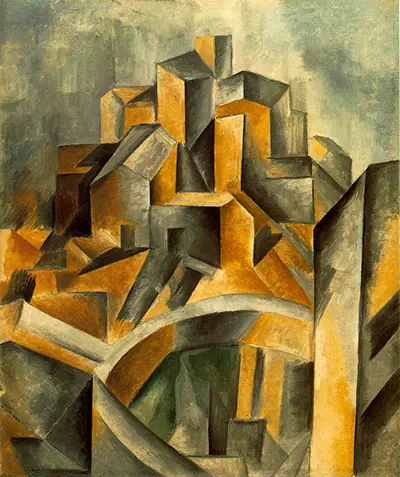It is an iconic painting in the development of Picasso's Cubist style, reproducing the landscape through geometric shapes which interlock with one another, taken from multiple perspectives and of various planes.
In Picasso's depiction of a Spanish landscape, he creates ambiguity in the shapes, movement and perspectives that he has chosen, mixing the growing height of the traditional stucco architecture in the background against the curved reservoir below.
The only softened round edge in the lower section of the painting creates a juxtaposition to the volume above. The period in which The Reservoir was created is considered a very productive time for Picasso in the development of his analytical Cubist style.
Characteristic of this style is the disruption of the normally romanticised depiction of rural landscapes in art. In fact, the very label of "landscape" was a shock to those viewing The Reservoir because the spatial depth is barely readable in the geometric forms and structures which Picasso paints in.
For instance, the perspective of each building depicted overlaps with the form of one another. Picasso also employed a subdued colour palette of ochre and green blended with white and black to create the effect of volume and blending.
The Reservoir was brought to Paris in September 1909 along with numerous other paintings created in Spain and packed into Picasso's returning luggage.
Picasso exhibited these works in private rooms at the Bateau-Lavoir that same month. The American writer Gertrude Stein was invited to this private viewing with her husband Leo.
Upon seeing his work, Stein organised a further exhibition in the rue de Fleurus for Picasso, which collected together many of his Spanish landscapes.
The Reservoir is currently owned and exhibited by The Museum of Modern Art, New York, where it was purchased from Gertrude Stein in 1968.
According the art historian Anne Baldassari (see Picasso and Photography, 1997), Picasso often utilised photographs to preserve perspectives which he later painted. Indeed, with The Reservoir Picasso is known to have taken many photographs, sending some of these and further pictures of his work to Gertrude Stein when painting in 1909.
Although photographs offered a means of conserving images of a landscape to be painted, they also represented an entirely different and naturalistic style to Picasso's work. Given the ubiquity of photographs — particularly landscape photography—during the early twentieth-century, Picasso's work can be seen as both a rejection of, but also as taking inspiration from, photographs.
Looking at Picasso's broad use of Cubism and its subversion of perspective could be read as anti-photographic in form and point-of-view.
After all, photography is often understood as seriously impacting the realism of such artistic practices as portraiture upon its widespread application in the nineteenth-century.
Photography also played a contextual influence for painting styles like Impressionism which rejected the mechanical nature of photography in capturing true moments.
In reacting to modern photography, Cubism and Picasso also utilise styles that are not tethered to the natural depiction of a landscape faithfully as in photography, but on their construction and conception in the mind and over time and space.
As such, The Reservoir made use of photographs Picasso took of the Spanish landscape during its painting, but drew upon these photographs in an original and interpretive way rather than as a means of reproducing a faithful reality.
Pablo Picasso co-founded the groundbreaking Cubist movement with Georges Braque and other artists heavily influenced by Paul Cézanne.
As with many European artists, Picasso lived and worked in Paris, often described as a "cultural capital" in the nineteenth and early-twentieth centuries.
Throughout Picasso's career, he has worked in various styles under several formats and through various artistic mediums, popularising collage and constructed sculpture.
He achieved his greatest critical acceptance through the Cubist style from the 1910s, but has trained and practiced several other styles since his first major exhibition in Paris in 1901, including Proto-Cubism, neoclassicism, Surrealism, Modernism and Post-Impressionism.
Cubism was a painting and sculpture style which radically shaped the trajectory of twentieth-century modern art; it was highly influential throughout Europe and farther afield, instigating responses such as Futurism, Dada, Constructivism, Art Deco and De Stijl.
Most influential was its blending of time, perspective, viewpoints and geometric forms.

